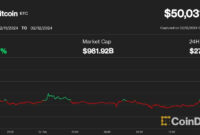Why crypto market is down today 2022? – cryptokinews.com
THIS year has already been a tough one for major cryptocurrencies including Bitcoin, Ethereum, BNB, Cardano and XRP.
The price of Bitcoin is down more than 5% over the last 24 hours, to $37,121.35, according to Coinmarketcap.

Today, the global crypto market is down almost 7% over the past 24 hours, with the biggest losers including big names like Bitcoin, Ethereum, Tether Binance coin (BNB), Cardano, XRP and Solana.
This comes after Russian president Vladimir Putin made a defiant speech amid escalating tensions on the Russia-Ukraine border.
Russia has previously announced a proposal to ban on cryptocurrency trades and mining.
In the past day, Ethereum is down more than 6%, Cardano has fallen almost 13% and Solana has fallen almost 12%.
XRP and BNB are down 12% and 7% over 24 hours respectively.
The latest plunge follows a crypto crash at the start of December, shortly after Bitcoin hit a record value of $69,000 in November.
Bitcoin has now lost well over one-third of that value.
One trader lost $5billion after the price of bitcoin plummeted in December, highlighting the risks of investing in crypto.
It comes as new research shows that 18.89million coins have been mined out of 21million, which is the maximum.
And in another recent blow to the market, Crypto.com users were unable to access funds due to “unauthorised activity” on some accounts.
Last year users of cryptocurrency exchange Binance were unable to access their cash after suspending UK withdrawals.
And Etoro customers were locked out of their accounts after the service went down during a crypto crash.
Crypto.com has also created its own digital coin with the same name, which plunged as much as 5% after the suspension was announced.
Potential interest rates hikes by the Fed would fight inflation – and therefore draw down the value further from cryptos, which have long been seen as an “inflation hedge”, a protected asset against rising market prices.
Fewer rising prices, means less love for cryptos.
Crypto volatility
The crypto market has also been battered by India’s plans to ban all private cryptocurrencies – aside from a few exceptions – and launch a central bank-backed digital currency of its own.
Cryptocurrencies are highly volatile, meaning their values often make large swings with no notice, as the latest plunge shows.
Investing in cryptocurrency is a very risky business.
You can be left with less money than you put in, and could even lose it all – even if you spend on what appears to be a safe bet.
You might not be able to access your investment if platforms go down and you could be left unable to convert crypto back into cash.
There have also been warnings around scams related to cryptocurrencies, with people losing vast sums of money.
You should never invest in something you don’t understand and you should never put in money that you can’t afford to lose entirely.
(Ad) An easier way to buy crypto with eToro
Join the 25 million users who trust their investments with eToro.
You can start investing from as little as $10.
Choose from a selection of crypto assets including Bitcoin, Ethereum and Dogecoin. You can practice risk-free, with a virtual investment account.
Own crypto with eToro
Cryptocurrency investing within the EU (by eToro Europe Ltd. and eToro UK Ltd.) & USA (by eToro USA LLC) is highly volatile, unregulated in most EU countries and the UK. No consumer protection. Not supervised by the EU or UK regulatory framework. Investments are subject to market risk, including the loss of principal. Tax on profits may apply.
Why have crypto markets been down?
Cryptocurrencies have been especially volatile lately and there a few reasons why.
Twitter’s chief financial officer Ned Segal said at the end of last year that investing in crypto “doesn’t make sense right now”, causing concern among Silicon Valley buyers.
Many crypto-mining regions in China are now radically reducing operations.
Previous moves by the country to crackdown on mining and trading of crypto has previously sent markets plunging.
And the unrest in Eastern Europe has contributed to the fall because investors tend to shun risk-sensitive assets during uncertain times.
How Experts Are Reacting to Swinging Crypto Prices
Experts say Russia’s invasion of Ukraine has pummeled risk assets while traditional safe havens like gold and the U.S. dollar are trading higher. For crypto investors, here’s what they say is moving the market right now:
Crypto Is Tracking the Stock Market
The case for Bitcoin as a “safe” asset like gold is weakening, because of its volatility and increased correlation to stock markets, says Ben McMillan, chief investment officer of IDX Digital Assets. For Bitcoin to experience a sustained rally past $45,000, there would need to be “a return of investor risk-appetite across asset classes which, for the time being, looks like it will be largely determined by the unfolding of events in Ukraine,” McMillan says.
Though crypto has long been championed by advocates as an asset uncorrelated from traditional financial markets, Boneparth says the crypto market is reacting to the news of Russia invading Ukraine in sync with stock markets.
“My first observation is something that we’ve observed before, which is that crypto, specifically Bitcoin and Ethereum, are risk-on assets,” says Boneparth. “They’re going up and down just like equities do. You watch stocks sell off overnight and throughout the day today, and you’re watching crypto pretty much do the same exact thing.”
Boneparth says time will tell if crypto investors were simply experiencing an initial knee-jerk reaction to the situation “Does [crypto] remove itself from being correlated to equities, or does it continue to follow the same pattern as equities? We’re going to find out,” he says.
More Mainstream Crypto Adoption
Mainstream adoption of crypto is what is causing the crypto market to increasingly move in sync with the capital markets, says Laura Shin, a crypto podcast host and author of “The Cryptopians: Idealism, Greed, Lies, and the Making of the First Big Cryptocurrency Craze.” The determining factor for how crypto markets do over the next few months is “whether the crypto die-hards or more macro-driven folks drive the narrative, and whether the crypto traders in leveraged positions get wiped out and drag the markets down with them,” she says.
Slumping Prices In Recent Months
The reaction of the crypto market right now is “somewhat normal” since it’s been in a decline over the last few months, according to Wendy O, a crypto investor and popular TikToker. She says we are seeing “more volatile bearish price action with global uncertainty,” and unless we are able to break out of Bitcoin’s current downtrend, the market will “continue to see lower highs.”
What Does This Mean for Investors?
Cryptocurrencies are highly volatile assets, a quality that’s even more pronounced than usual due to Russia’s attack on Ukraine.
Experts say the best thing investors can do right now is stay calm and avoid knee-jerk reactions to the changes in the market. Instead, stick to your long-term investment strategy. If you don’t have a long-term plan, Boneparth strongly suggests making one now.
“Be very careful to not make financial mistakes that you’ll regret down the road, because you either panicked or couldn’t handle the volatility that’s taking place,” says Boneparth. “Your ability to stay disciplined and stay invested is ultimately what will lead to success or failure.”
While there probably aren’t any immediate changes crypto investors should make, it’s a good reminder that crypto assets are extremely volatile. That’s why experts say most investors should stick to the big two cryptocurrencies, Bitcoin and Ethereum, and only invest what they’re OK with losing or no more than 5% of their total portfolio.
Always prioritize important aspects of your finances, such as saving for emergencies, paying off high-interest debt, and saving for retirement, ahead of cryptocurrency investments. As for where you buy and trade crypto, stick with a mainstream, high-volume cryptocurrency exchange, like Coinbase or Gemini, that proactively complies with evolving federal and state regulators.


